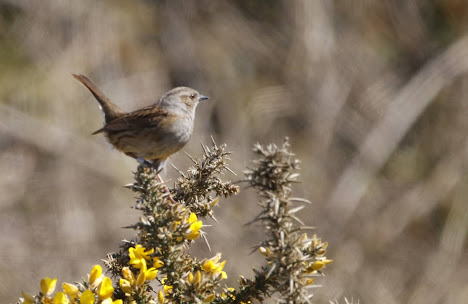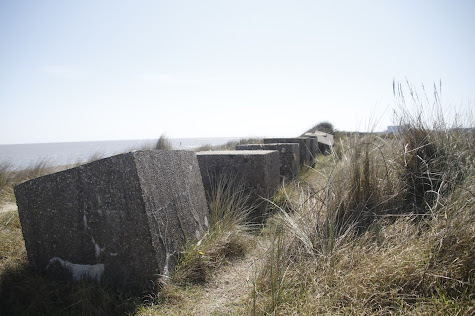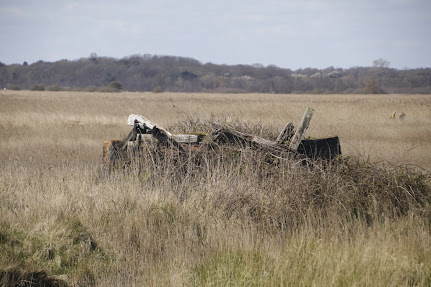At last, after a winter spent in lockdown, with only local visits to local sites possible, the world has finally opened up. As I haven't visited Minsmere since early December I was really missing the place and the birds that inhabit it. For this reason I decided to make Minsmere my first point of call when it reopened. April is a great time for birds with Spring migration really gearing up up as millions of birds are on the move, as they take the journey from their wintering grounds to look for a place to nest in their breeding grounds. At this time of year anything is possible, and there is no guarantee what will turn up.
This has been a strange Spring so far. Record temperatures in March led to an early influx in summer migrants to out shore, yet the cold northerly winds in April has changed this, with spring migration really slowing down. Today at Minsmere where a dearth of migrants was noticeable it was fairly uneventful. However there are always birds at Minsmere and on a beautiful warm, sunny day it was a good time to be out birdwatching.
Today wasn't a classic spring day at Minsmere, with nothing out of the ordinary to see. One of the joys of this time of year is the breeding birds, which inhabit Minsmere in mind boggling numbers. On the Scrape, birds jam pack into the many islands, thousands of birds nesting and territorial marking, cheek by jowl with each other, creating a cacophony of sounds. Unfortunately, due to the coronavirus keeping us in semi lockdown, the hides were closed so views of the Scrape were reduced to scoping from the dune tops, although the Public Viewpoint was open which gave views of South Scrape. Being very sunny there was a shimmer on the water which restricted a lot of viewing when seen from afar.
At this time of year the Scrape is speckled with white as the thousands of BLACK HEADED GULLS nest on the Scrape. This is the most abundant species on the Scrape providing sanctuary to the rarer birds that nest here. Amongst them were the usual MEDITTERANEAN GULLS, a bird which looks similar to the black headeds but has a subtly different plumage, which stands out when you get your eye in. A small flock of 20+ SANDWHCIH TERNS were also present although their number could be higher as there was much interchange between the Scrape and the sea. These large, black-billed terns are only an erratic breeder at Minsmere, so it s a case of wait and see as to whether they will settle down here or move on to somewhere else. A first summer LITTLE GULL, flew from the Scrape, over West Hide and over the reedbeds which was a nice spot, this is a good time to see them. As its name suggests its a lot smaller than the other gull species that inhabit Minmsere.
Out on the Scrape there were still plenty of DUCKS about, at this time of year the males look splendid, the brownie females less so. SHOVELLER were the most common, this beautiful duck nests at Minsmere in large numbers, there is a nationally significant population here. A few ducks of other species were about, including a pair of PINTAIL on South Scrape. There were lots of BARNACLE GEESE, these naturaliesd birds have taken over the Scrape and have ousted the other species of goose, which were also introduced, so don't feel sorry for them.
With water levels high on the Scrape, WADERS were few in number. A nice BAR TAILED GODWIT in brick red breeding plumage was about on East Scrape, as well a a couple of TURNSTONE, some summer-plumaged BLACK TAILED GODWIT and a few RINGED PLOVERS, although the latter may nest here. Of the breeding waders, black and white AVOCET were in the largest number, probably the most famous bird of Minmsere, with LAPWING in the grassy areas in front of North Hide and some OYSTERCATCHERS, birds flying high to see off a marauding large gull.
The Scrape is bordered on one side by the beach and it was here that attention was turned to the smaller birds. There were two pairs of STONECHAT present, one behind East Hide and one by the sluice bushes, these birds nest in the copious amounts of gorse on the beach, the smell of coconuts wafting down from these thorns. There were lots of LINNETS with several flying in from the sea, the birds actively migrating at this time. Opposite West Hide two singing SEDGE WARBLERS were a first for the year for me their agitated song erupting from the reeds. It will be a couple more weeks before the similar sounding reed warbler shows up.
SAND MARTINS nest in the old car park, a former quarry next to the visitors centre. Only a few birds were present here, but large numbers were about hawking for insects over the Scrape and reedbeds. It won't be long before they start to recolonise the holes in the sandy cliffs and settle down to raise a family.
High above the reeds MARSH HARRIERS were busy preparing for the breeding season, and although Island Mere hide was closed views over the reeds were still available. Out on the water there was a pair of GREAT CRESTED GREBE and some TUFTED DUCK, the usual breeding birds of this mere.
Although the birds are the most noticeable of our wildlife, Minsmere abounds in other forms of life. On the Stone Curlew Field a STOAT was briefly seen running across the heathy grassland. Similar but larger than a weasel, with rabbits now recovering from the last bout of mixamatosis, there was plenty of food for the stoat to hunt. On the Levels, an area of wet grassland close to Sizewell, a herd of 15 RED DEER, mainly hinds, were present grazing in the distance.









No comments:
Post a Comment